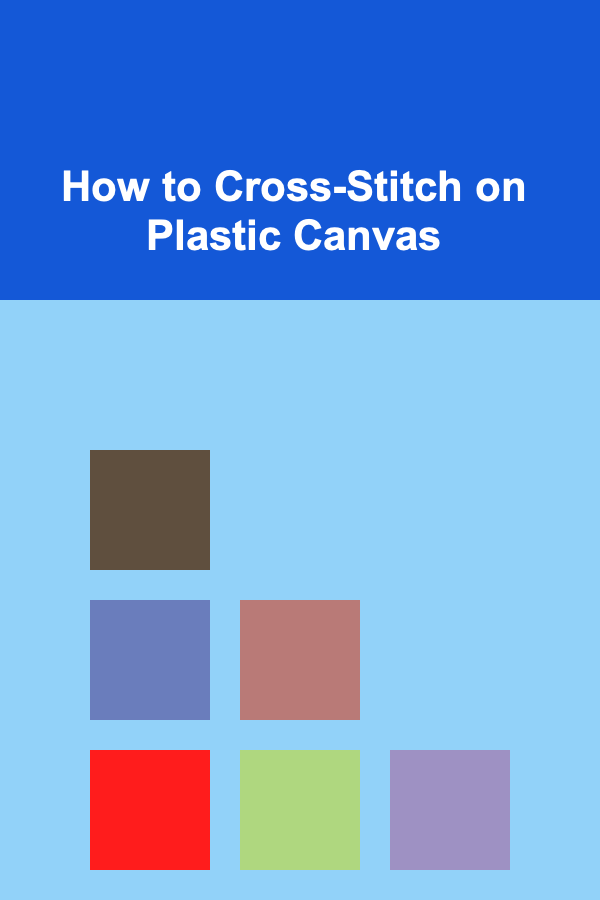
How to Cross-Stitch on Plastic Canvas
ebook include PDF & Audio bundle (Micro Guide)
$12.99$5.99
Limited Time Offer! Order within the next:

Cross-stitching is a timeless form of needlework that has gained popularity for its simplicity, beauty, and versatility. Whether you're a beginner or an experienced crafter, there's always something new to learn when it comes to cross-stitching. One particular variation of this craft that has captured the attention of many is cross-stitching on plastic canvas. Plastic canvas offers a unique and durable medium that can be used to create intricate designs, 3D objects, and decorative items that stand the test of time.
In this guide, we will walk you through everything you need to know about cross-stitching on plastic canvas. From choosing the right materials to mastering the technique, this article will provide you with all the essential information to help you start creating beautiful plastic canvas projects.
What is Plastic Canvas?
Plastic canvas is a type of stiff, flexible plastic mesh that is commonly used in needlework projects, particularly cross-stitching. Unlike traditional fabric, which can be quite soft and delicate, plastic canvas provides a sturdy base that allows the stitches to hold their shape. It is often used to create items like bookmarks, coasters, ornaments, keychains, and even 3D objects like boxes or tissue holders.
Plastic canvas is available in various sizes and thicknesses, and it typically comes in a grid-like pattern, with evenly spaced holes that make it easy to stitch. The holes are typically large enough to accommodate embroidery floss or yarn, making it an ideal material for a range of stitching techniques.
Why Choose Plastic Canvas for Cross-Stitching?
There are several reasons why plastic canvas is an excellent choice for cross-stitching:
- Durability: Plastic canvas is tough and resistant to wear and tear. It holds its shape well, even with repeated handling.
- Versatility: Plastic canvas can be used to create both flat and 3D projects. Its sturdiness allows for more complex designs, such as boxes or stand-alone pieces.
- Ease of Use: The firm texture of plastic canvas makes it easier to work with compared to softer fabrics, especially for beginners.
- Affordability: Plastic canvas is inexpensive and readily available at most craft stores, making it an accessible choice for all crafters.
Materials Needed for Cross-Stitching on Plastic Canvas
Before you begin cross-stitching on plastic canvas, it's important to gather all the necessary materials. Here's a list of the essential supplies you'll need for a successful project:
1. Plastic Canvas
Plastic canvas comes in various mesh sizes, typically ranging from 7-count (the most common size) to 14-count, 10-count, or even larger. The number refers to the number of holes per inch in the canvas. A 7-count canvas has 7 holes per inch, whereas a 14-count canvas has 14 holes per inch. The smaller the count, the larger the holes.
- 7-count is perfect for beginners, as the holes are larger and easier to stitch.
- 10-count and 14-count are better suited for more advanced projects that require finer detail.
2. Embroidery Floss or Yarn
Embroidery floss or yarn is used to create the stitches on the plastic canvas. Embroidery floss is made of six strands that can be separated for finer stitching, while yarn is typically thicker and works well for bolder designs.
- Embroidery Floss is ideal for detailed projects and smaller designs.
- Yarn works best for larger projects or when you want a more textured look.
3. Needles
You'll need a needle that fits through the holes in the plastic canvas. Plastic canvas needles are specially designed with blunt tips and large eyes to accommodate embroidery floss or yarn. The size of the needle should match the count of your canvas:
- For 7-count plastic canvas, use a blunt-end needle size 18-22.
- For 10-count and 14-count plastic canvas, use blunt-end needles size 24-26.
4. Scissors
A good pair of scissors is essential for cutting the embroidery floss or yarn to the proper length. Precision cutting is key to avoid fraying your threads.
5. Chart or Design Pattern
Having a cross-stitch pattern or chart is essential for creating your design. The pattern will guide you on where to place each stitch, and it typically includes a color guide to help you select the right floss or yarn.
6. Ruler and Pen or Pencil
A ruler will help you measure and cut the plastic canvas to the desired size, while a pencil or fabric-safe pen can be used to mark any measurements or design outlines on the canvas.
Preparing the Plastic Canvas
Before you begin stitching, it's important to prepare your plastic canvas and workspace. Here's how to get started:
1. Cutting the Canvas
If you're working with a larger sheet of plastic canvas, you'll need to cut it to the desired size for your project. Use a ruler and scissors to measure and cut the canvas accurately. Be sure to cut straight lines, as uneven edges can make stitching more difficult.
2. Marking the Canvas
If your pattern requires specific markings, use a pencil or fabric-safe pen to lightly outline the areas where you'll be stitching. This step is particularly helpful when working with more complex designs. Make sure to use light marks that can easily be erased or washed off later.
3. Prepare Your Thread
Cut a length of embroidery floss or yarn. It's best to cut thread in lengths of about 18 inches to prevent tangling. For a finer finish, you can separate the strands of embroidery floss, but this will depend on the type of design you're creating. If you're using yarn, you can stitch with the yarn as it is or separate it if desired.
4. Setting Up Your Needle
Thread your needle with the chosen embroidery floss or yarn. Make sure you have enough thread to complete several stitches without having to re-thread your needle too often. Tie a small knot at the end of the thread to prevent it from slipping through the holes of the canvas.
Basic Cross-Stitch Technique on Plastic Canvas
Now that your materials are prepared, it's time to start stitching. Follow these simple steps for basic cross-stitch on plastic canvas:
1. Start at the Center
Most cross-stitch projects begin at the center of the canvas. Fold the canvas in half both horizontally and vertically to find the center, or measure from the edges to mark the center point with a pencil or fabric-safe pen. This will help you ensure that your design is centered on the canvas.
2. Making the Stitches
To create a cross-stitch, insert the needle from the back of the canvas into one hole, pulling the thread through until the knot stops it. Then, move your needle diagonally to the opposite hole in the adjacent square, creating a "X" shape. Once you've completed one leg of the cross, go back and complete the second leg in the same way. Continue this process, filling in the design following the pattern.
3. Using the "Half Stitch"
A half stitch is often used to create diagonal lines or intricate designs on plastic canvas. To create a half stitch, simply stitch one leg of a cross-stitch and leave the other leg incomplete.
4. Color Changes
Follow the pattern's color guide to change thread colors as needed. When switching threads, tie a knot at the end of the old color and begin with the new color. Keep your stitches neat and tidy, and try to carry the threads across the back of the canvas to avoid excess knots or tangled threads.
5. Finishing a Thread
When you run out of thread, simply tie a small knot at the back of the canvas and trim the excess thread. Begin a new piece of thread by tying a knot at the end and continuing your stitching.
Advanced Techniques for Cross-Stitching on Plastic Canvas
Once you've mastered the basic cross-stitch technique, you can experiment with more advanced techniques to add texture and dimension to your plastic canvas projects. Here are a few ideas to elevate your designs:
1. Backstitching
Backstitching is a popular technique used to outline designs, add detail, and create definition in cross-stitch projects. To backstitch, simply insert the needle into a hole, and then stitch backwards through the holes to create a solid line.
2. French Knots
French knots are small, raised knots that add texture to a design. To create a French knot, wrap the thread around the needle two or three times, insert the needle back into the canvas, and pull through to form the knot. French knots are great for adding small details like flower centers or decorative accents.
3. 3D Projects
Plastic canvas allows for the creation of 3D objects, such as boxes, ornaments, or figures. After completing the basic stitching, you can use a needle and thread to stitch the edges of your pieces together, creating a sturdy structure. You can even use stuffing to add dimension and make your projects stand out.
4. Adding Embellishments
To enhance your projects, you can incorporate embellishments like beads, sequins, or ribbons. These items can be sewn onto the canvas after completing the cross-stitching, adding sparkle and texture to your design.
Finishing Your Cross-Stitch Project
Once your design is complete, it's time to finish your plastic canvas project. Here's how to wrap up your work:
1. Trimming the Edges
Trim the edges of the canvas to remove any excess, leaving a small border around your stitches. Be careful not to cut too close to the stitches, as this can cause the design to unravel.
2. Securing Loose Threads
Check the back of your canvas for any loose threads. Secure them by tying small knots and trimming any excess. Make sure the back is neat to avoid it affecting the overall appearance of your project.
3. Display or Assemble Your Project
Depending on your design, you can either frame your project, turn it into a functional item (like a coaster or bookmark), or assemble it into a 3D shape. Plastic canvas projects can be displayed as standalone pieces or incorporated into larger designs.
Conclusion
Cross-stitching on plastic canvas is an enjoyable and rewarding craft that allows you to create a wide variety of beautiful and functional pieces. By following the steps outlined in this guide, you can learn how to work with plastic canvas and explore the many possibilities it offers. Whether you're a beginner or an experienced crafter, plastic canvas cross-stitching is a great way to unleash your creativity and produce one-of-a-kind items that will stand the test of time. So gather your materials, pick a pattern, and start stitching!
Reading More From Our Other Websites
- [Home Budget 101] How to Budget for Home Improvements During Retirement
- [Personal Care Tips 101] How to Get Rid of Dandruff and Maintain a Healthy Scalp
- [Organization Tip 101] How to Organize Bookshelves in Your Bedroom
- [Home Renovating 101] How to Unlock Your Home's Potential: Attic Conversion Ideas for Every Budget
- [Personal Investment 101] Monetizing Deep Learning: How to Turn Your Skills into Cash
- [Home Cleaning 101] How to Clean and Maintain Wooden Floors
- [Needle Felting Tip 101] Advanced Techniques: Adding Texture and Color Depth in Needle Felting
- [Organization Tip 101] How to Replace and Repair Carpet Tiles Without Hassle
- [Personal Investment 101] How to Reduce Market Risk with Dollar-Cost Averaging
- [Organization Tip 101] How to Organize Photographs and Digital Media Files

How to Create a Secure Digital Archive for Important Documents
Read More
How to Maintain Your Home's Air Conditioning Unit to Extend Its Life
Read More
How to Optimize Your Event Schedule for Efficiency
Read More
How to Optimize Your YouTube Videos for Search (SEO Tips)
Read More
How to Use Motion Sensors to Improve Your Home Security
Read More
10 Tips for a Weekly To-Do List for Students
Read MoreOther Products

How to Create a Secure Digital Archive for Important Documents
Read More
How to Maintain Your Home's Air Conditioning Unit to Extend Its Life
Read More
How to Optimize Your Event Schedule for Efficiency
Read More
How to Optimize Your YouTube Videos for Search (SEO Tips)
Read More
How to Use Motion Sensors to Improve Your Home Security
Read More